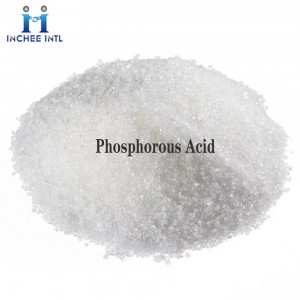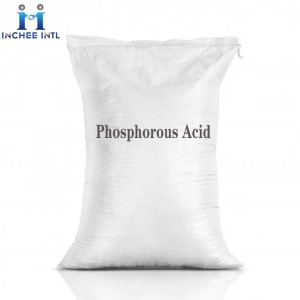Phosphorous Acid,an inorganic compound with the chemical formula H3PO3. It is a white crystalline powder, easily soluble in water and ethanol, and slowly oxidized into orthophosphate in air. Phosphite is a dibasic acid, its acidity is slightly stronger than phosphoric acid, it has strong reducing property, easy to reduce silver ions (Ag+) to silver metal (Ag), can reduce sulfuric acid to sulfur dioxide. It has strong hygroscopicity and deliviousness, and is corrosive. Phosphite is mainly used as reducing agent, nylon brightening agent, but also used as phosphite raw materials, pesticide intermediates and organic phosphorus water treatment agents raw materials.

Properties: white crystalline powder. Soluble in water and alcohol.Density: 1.651g/cm3, melting point: 73℃, boiling point: 200℃.
APPLICATION:
1.Phosphorous acid is used to produce the fertilizer phosphate salt like potassium phosphite, ammonium phosphite and calcium phosphite. It is actively involved in the preparation of phosphites like aminotris(methylenephosphonic acid) (ATMP), 1-hydroxyethane 1,1-diphosphonic acid (HEDP) and 2-phosphonobutane-1,2,4-tricarboxylic Acid (PBTC), which find application in water treatment as a scale or corrosive inhibitor. It is also used in chemical reactions as a reducing agent. Its salt, lead phosphite is used as PVC stabilizer. It is also used as a precursor in the preparation of phosphine and as an intermediate in the preparation of other phosphorus compounds.
2.Phosphorous acid (H3PO3, orthophosphorous acid) may be used as one of the reaction components for the synthesis of the following:
α-aminomethylphosphonic acids via Mannich-Type Multicomponent Reaction
1-aminoalkanephosphonic acids via amidoalkylation followed by hydrolysis
N-protected α-aminophosphonic acids (phospho-isosteres of natural amino acids) via amidoalkylation reaction
3. Industrial uses:This collector was developed recently and was used primarily as specific collector for cassiterite from ores with complex gangue composition.On the basis of the phosphonic acid, Albright and Wilson had developed a range of collectors mainly for flotation of oxidic minerals (i.e. cassiterite, ilmenite and pyrochlore). Very little is known about the performance of these collectors. Limited studies conducted with cassiterite and rutile ores showed that some of these collectors produce voluminous froth but were very selective.
Production method:
Industrial production methods include trichloroic phosphorus and phosphoric acid salt. The hydrolysis method slowly adds water to the hydrolysis reaction under the mixing of the trichloride to generate sub -phosphoric acid. After refining, cold ChemicalBook, the crystallization and discoloration are made, and the finished product is made. Its PCI3+3H2O → H3PO3+3HCL produces hydrogen chloride recycling during the production process, which can be made into hydrochloric acid.
Security:
Flammability risk characteristics: in H hole agent combustible; Heat decomposes toxic phosphorus oxide fumes.
Storage and transportation characteristics: warehouse ventilation low temperature dry; Store separately from H pore-releasing agent and alkali.
Packing: 25kg/Bag
Storage: Preserve in well-closed, light-resistant, and protect from moisture.

Post time: Feb-27-2023






